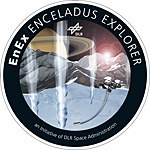The EnEx Initiative

As a result of this ice volcanism (cryovolcanism) in the Saturnian system, which was detected for the first time, ice particles from the moon's surface are ejected approximately 500 kilometres into space. For this process to take place, liquid water must exist beneath the surface of the ice, which is forced upwards through cracks and fissures in the moon's icy shell. Due to the extremely low ambient pressure on the surface, the previously liquid water vaporises and freezes immediately before escaping in the form of ice particles.
What is interesting for the search for extraterrestrial life is not only the existence of liquid water under the icy surface, but also the presence of organic compounds in the ice fountains. According to current astrobiological concepts, Enceladus thus fulfils the basic requirements for the existence of life. However, the hostile environmental conditions mean that possible organic life forms are unlikely to be found on the surface of Enceladus, but are more likely to be found in the liquid water deposits beneath the ice shell. The thickness of the ice shell can range from a few metres to several kilometres.
Living Microorganisms could exist under Enceladus' icy Shell
From a technical point of view, this represents a major challenge. One approach to solving this is the space mission 'EnEx - Enceladus Explorer'. Researchers are currently working on the basis of the following scenario: Microorganisms that may have developed in the water reservoirs below the ice sheet are also carried along in the water that is pushed up through cracks and fissures and escapes through the cryovolcanoes.

As soon as the ambient pressure has dropped to a certain level during this ascent, the microorganisms burst, leaving behind the organic compounds detected in the fountains. If it were possible to take a sample of the rising and still liquid water from a cryovolcano's 'vent', the microorganisms contained therein would possibly still be alive.
It could possibly be sufficient to 'tap' a cryovolcano at a depth of around 100 metres to take a sample. This requires a melting probe that can move three-dimensionally in the solid ice. The probe must be able to reliably locate an ice fissure containing liquid water over a distance of more than 100 metres as well as any cavities that it has to avoid. Based on this information, it must then be able to plan and follow its path from the surface to its destination completely autonomously.
An important milestone on the way there has already been achieved: The IceMole probe was developed as part of the EnEx mission. In November 2014, this probe enabled scientists to take water samples from under the ice layer in the Antarctic and bring them to the surface without contamination for the first time in history. What has already been achieved at the Antarctic 'Blood Falls' on Earth will later be realised in a similar way on Saturn's moon Enceladus.
These new space technologies are being developed in the EnEx initiative projects funded by the German Space Agency at DLR. The project partners are FH Aachen, RWTH Aachen University, the University of the Federal Armed Forces in Munich, TU Braunschweig, the University of Bremen and the University of Wuppertal. The long-term goal of the initiative is to realise the Enceladus Explorer space mission.

